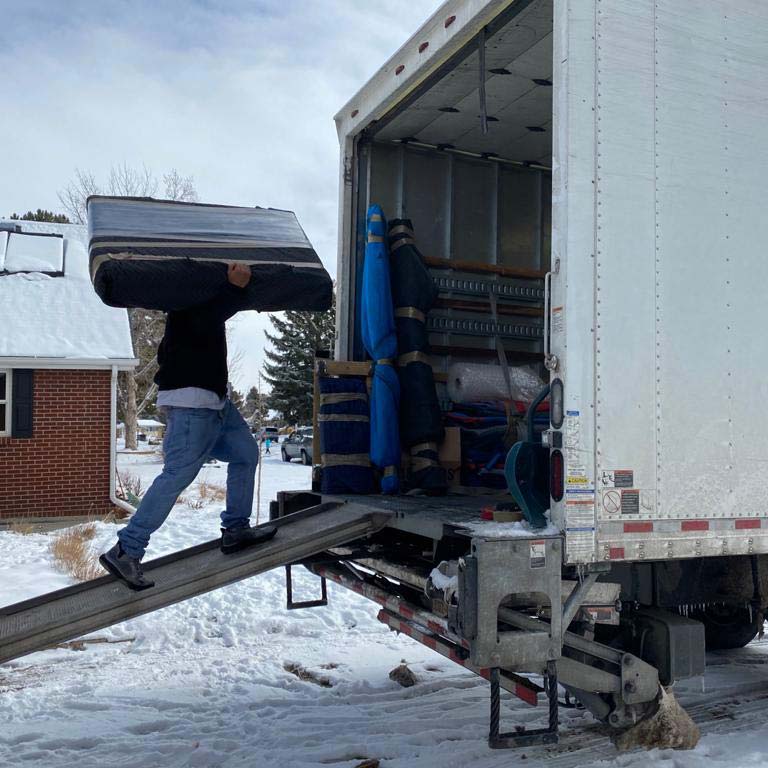The trend toward remote work has significantly reshaped where and how people live, substantially impacting relocation patterns and moving company services. Remote work allows employees to work anywhere with an internet connection, freeing them from the need to live close to their office. As a result, many have opted for more affordable, spacious, or desirable locations, such as suburban areas, rural towns, or even different countries.
This has led to a shift away from densely populated urban centers and a surge in demand for housing in previously less-occupied regions. Consequently, moving companies have witnessed a shift in their services. They now face increased demand for long-distance moves, often over greater distances. People moving to more remote or rural areas may also require specialized services to navigate unique challenges like rugged terrain or limited infrastructure.
Remote work has prompted a widespread reevaluation of where people choose to live, leading to increased demand for moving company services for longer-distance and often more complex relocations. This trend will likely persist as remote work continues to be a viable option for many employees. Is it a major concern? Is it a changing job market fact?

The Evolution of Remote Work
Remote work, also known as telecommuting or working from home, has evolved significantly over time. In the past, most jobs required people to be physically present at an office or workplace. However, technological advancements, especially the internet and communication tools, have revolutionized how we work.
The first phase of remote work involved basic tasks like making phone calls and answering emails from home. This was often a rare privilege for some employees. Then came the era of more advanced remote work. Companies started allowing employees to work from home part-time or on specific days, thanks to improved internet connectivity and remote access to company systems. This change offered more flexibility and work-life balance.
Now, remote work is a mainstream option for many industries. Companies are rethinking their office spaces, focusing on flexibility, and hiring talent from anywhere globally. This evolution has also prompted discussions about the future of work, emphasizing results and productivity over physical presence. It has come a long way from being an occasional luxury to a fundamental aspect of the modern work landscape, reshaping how we work, where we work, and how businesses operate.
 The Surge of Remote Workers Since the Pandemic Began
The Surge of Remote Workers Since the Pandemic Began
The COVID-19 pandemic has brought about an unprecedented surge in remote work since it began. As lockdowns and safety concerns forced businesses to adapt, millions of employees worldwide transitioned to remote work almost overnight. This surge was driven by the necessity to maintain business continuity while safeguarding employees’ health.
Many businesses had to adapt quickly to lockdowns and social distancing measures. They shifted to a remote-first model, where most employees worked from home full-time. Companies embraced digital tools like video conferencing, project management software, and virtual collaboration platforms to keep operations running smoothly. Also, employees discovered the benefits of flexibility, eliminating lengthy commutes, and achieving better work-life balance.
The wave of remote work also had far-reaching implications for urban migration, as many people moved away from expensive city centers in search of more affordable and spacious living arrangements. This trend challenged conventional notions of where to live to access job opportunities, potentially reshaping urban planning and the real estate market.
 Remote Work vs. Traditional In-Office Work: A Comparative Analysis
Remote Work vs. Traditional In-Office Work: A Comparative Analysis
Remote and traditional in-office work has distinct advantages and disadvantages. The choice between them depends on various factors. Here’s a comparative analysis to help understand the differences:
- Flexibility. Remote Work: Provides flexibility, allowing employees to set schedules and work from anywhere with internet connection. In-Office Work: Typically follows a fixed schedule and requires employees to be physically present at a specific location.
- Commute. Remote Work: Eliminates commuting, saves time and money, and reduces stress. In-Office Work: Often involves daily commuting, which can be time-consuming and tiring.
- Collaboration. Remote Work: Relies heavily on digital tools for collaboration, which can sometimes lead to communication and team bonding challenges. In-Office Work: Offers face-to-face interaction, promoting spontaneous collaboration and faster decision-making.
- Work-Life Balance. Remote Work: Provides better work-life balance as employees can manage personal and professional responsibilities more flexibly. In-Office Work: May struggle to maintain work-life balance due to longer hours and commutes.
- Productivity. Remote Work: Can enhance productivity for some due to reduced distractions, while others may find it challenging to stay focused at home. In-Office Work: A structured environment can promote productivity, but distractions exist.
- Company Culture. Remote Work: Requires extra effort to build and maintain a strong company culture. In-Office Work: Benefits from face-to-face interactions for culture building.
- Employee Well-being. Remote Work: Can reduce stress and improve mental health by eliminating the commute and offering flexibility. In-Office Work: May lead to stress related to commuting and rigid schedules.
- Environmental Impact. Remote Work: Reduces emissions and environmental impact associated with commuting. In-Office Work: Typically contributes to carbon emissions from daily commuting.
 The Growing Preference for Working Remotely: What the Data Shows
The Growing Preference for Working Remotely: What the Data Shows
The preference for remote work has grown significantly. A survey by FlexJobs in 2021 found that 65% of workers prefer a fully remote or hybrid work model. The reasons include better work-life balance (75%), avoiding commuting (69%), and increased productivity (46%). Also, many believe remote work improves mental health (45%) and reduces stress (42%). This shift is partly due to the COVID-19 pandemic, which accelerated remote work adoption. Companies are adapting, with 97% offering some form of remote work. Remote work trends also show more people considering relocating away from expensive cities, leading to changes in housing markets and urban planning. This data indicates that remote work is a preferred and sustainable work model for many.
 Economic Innovation Groups Take on Remote Work Trends
Economic Innovation Groups Take on Remote Work Trends
Economic Innovation Groups are paying attention to remote work trends. They see that remote work is changing where people live and work. This could benefit less-developed areas by attracting remote workers and businesses. These groups promote policies encouraging this one trend, like improving internet access in rural areas and providing tax incentives for remote workers and companies. They believe remote work can boost local economies and reduce inequality by spreading economic opportunities to previously overlooked regions. So, they are working to support and maximize the positive impacts of remote work on various communities.

The Impact on Relocation Patterns
Remote work has shifted relocation patterns significantly. With the freedom to work from anywhere, people are moving away from expensive cities to more affordable and desirable locations. Suburbs, rural areas, and smaller towns are experiencing increased demand for housing. This trend has also led to challenges and opportunities in urban planning, as cities need to adapt to changing population dynamics. Ultimately, remote work has reshaped where people choose to live, impacting both urban and rural areas and the housing market.
 Rural and Suburban Areas: The New Haven for Remote Employees?
Rural and Suburban Areas: The New Haven for Remote Employees?
While some are ditching Colorado–for more information on why, check out the Exiting Colorado Guide—others are flocking to the Centennial State for remote work. Rural and suburban areas have become attractive havens for remote employees for several compelling reasons.
- Cost of Living: Rural and suburban areas often offer a lower living cost than big cities. Housing is more affordable, and daily expenses like groceries and transportation can be significantly cheaper. Remote workers can stretch their incomes further, leading to a higher quality of life.
- Space and Comfort: These areas provide spacious homes with larger yards and more green space. This appeals to remote workers seeking a comfortable and peaceful environment. It’s an escape from the cramped urban living spaces and noise.
- Commute Reduction: One of the biggest advantages is the elimination of daily commutes. Remote employees save time, money, and reduce stress by avoiding long drives or crowded public transport, improving work-life balance.
- Family Friendly: Families find rural and suburban areas appealing due to better schools, safer neighborhoods, and more community-oriented environments. Parents can be more present for their children’s needs while working remotely.
- Lower Population Growth Rates: With fewer people, these areas may have lower pollution levels and less congestion, resulting in a healthier living environment.
- Cultural Appeal: Some remote workers appreciate the cultural aspects of rustic and suburban living, including local festivals, close-knit communities, and a slower pace of life.
It’s important to note that remote work in rural areas can also present challenges, such as limited access to certain amenities, healthcare facilities, or job opportunities for a partner. Despite these challenges, the benefits of rural and residential living have made them appealing choices for many remote employees seeking a more balanced and fulfilling lifestyle.
 Population Growth in Unexpected Regions: The Remote Work Effect
Population Growth in Unexpected Regions: The Remote Work Effect
Remote work has had a notable impact on population growth in unexpected regions. Before the rise of remote work, population growth was often concentrated in urban areas with thriving job markets. However, as remote work became more prevalent, people started seeking alternative living arrangements. This shift in work culture has led to a noticeable influx of residents into rustic and suburban areas previously experiencing population declines.
One of the key factors driving this trend is the desire for a better quality of life. Remote work has allowed individuals and families to escape big cities’ high costs, congestion, and stresses, opting for quieter, more affordable, and more spacious environments. This, in turn, has rejuvenated rural and suburban communities that were struggling with dwindling populations.
Another contributing factor is the ability to choose one’s location independently of job proximity. Remote work has enabled individuals to live in more attractive regions, such as areas with natural beauty, better schools, and a stronger sense of community. This has led to an unexpected revival of these regions, boosting local economies and stimulating housing markets.
 Population Decline in Large Urban Counties: A Shift in Dynamics
Population Decline in Large Urban Counties: A Shift in Dynamics
The rise of remote work has triggered a significant shift in the population dynamics of large urban counties. Traditionally, these urban centers attracted people seeking job opportunities and career advancement. However, remote work has begun to alter this trend.
- Population Decline Reversal: Many large urban counties are now experiencing a reversal in population decline. Before the remote work era, these areas often saw people moving out due to high costs of living, traffic congestion, and limited housing options. However, remote work has prompted some individuals and families to reconsider urban living. They are drawn to the idea of living in more affordable and spacious suburban or rural areas while still holding urban jobs.
- Relocation to the Outskirts: Some remote workers choose to relocate to the outskirts of large urban areas or even to entirely different regions, taking advantage of remote work’s flexibility. This trend has increased demand for housing in suburbs and small towns surrounding major cities, driving up property values in these areas.
- Impact on Urban Economy: The shift in population dynamics has financial implications for large urban counties. As residents leave for more affordable locales, there is potential for a decrease in local spending, impacting the local economy. However, some urban businesses are adapting by downsizing office spaces or offering hybrid work arrangements to retain employees.
- Urban Renewal and Adaptation: In response to these changes, some large urban counties are reevaluating their urban planning and infrastructure. They’re focusing on creating more livable, sustainable, and affordable urban environments to attract and retain residents. Initiatives like affordable housing projects, improved public transportation, and revitalized city centers are becoming more common.
- Potential for Hybrid Model: While remote work has shifted population dynamics, it’s worth noting that only some are leaving cities. Many still prefer the amenities, culture, and opportunities that urban living provides. This has given rise to the possibility of a hybrid model, where people split their time between urban and rural/suburban areas, depending on their work and lifestyle preferences.
Remote work has brought about a noticeable shift in the population decline trends of large urban counties. As remote work continues to evolve, urban areas adapt to attract and retain residents in this new era of work and living preferences, leading to changes in the urban landscape and the potential for more diverse and flexible housing options.
 How Remote Work is Reshaping Population Trends Globally
How Remote Work is Reshaping Population Trends Globally
Remote work is reshaping population trends worldwide. Before, people often flocked to big cities for job opportunities, causing urbanization. But with remote work, this is changing. People are leaving crowded urban centers for a better quality of life. They’re moving to rural areas, suburbs, and even different countries. This shift has altered population patterns.
- Urban Exodus: Many are leaving expensive and congested cities. They seek affordable housing, less pollution, and reduced commuting, particularly during the COVID-19 pandemic.
- Rural Renaissance: Remote work allows people to live in peaceful, spacious environments. Rural areas are seeing newfound growth, which can boost local economies.
- Global Mobility: Remote work isn’t confined by borders. People are moving to countries with a lower cost of living or better lifestyles. This has prompted governments to introduce policies to attract remote workers.
- Demographic Changes: Remote work has implications for demographics. Families are reconsidering where to raise children, and older adults are retiring in more desirable locations.
Remote work is decentralizing where people choose to live and work, profoundly affecting urbanization, rural development, and international migration patterns. This transformation is likely to continue as remote work becomes a long-term trend.

The Moving Industry’s Response
The moving industry has undergone significant changes in response to the rise of remote work, with shifting trends in gas prices and movers, increased emphasis on choosing the right movers, and integrating remote work into their operations.
Fluctuations in gas prices have long been a significant factor in the moving industry. As more people choose to work remotely, they increasingly relocate to areas with lower living costs, such as suburban or rural regions. This trend has led to longer-distance moves. When gas prices rise, it can impact the cost of long-distance moves, as fuel costs are a significant expense for moving companies. Many movers have adopted strategies to optimize fuel efficiency to remain competitive and attract remote workers seeking affordable living options, such as using more fuel-efficient vehicles or adjusting pricing structures to account for fuel price fluctuations.
With remote work enabling greater flexibility in where people choose to live, the importance of selecting the right moving company has grown. Remote workers and families pay a premium for the quality, reliability, and professionalism of moving services. Online reviews and recommendations have become crucial in decision-making, allowing individuals to research and choose movers with a solid track record. Movers are responding by investing in their online presence, customer service, and transparency to meet the growing demand for trustworthy and efficient relocation services.
Working Remotely
The remote work trend has also influenced how moving companies interact with their clients. With more people working remotely, the initial stages of the moving process, such as obtaining quotes and planning logistics, are increasingly conducted online or over the phone. Movers have adapted by offering virtual consultations and improving their online platforms to facilitate remote interactions. This has made moving more convenient and accessible for individuals and families who cannot visit a physical office during the planning stages.
The moving industry has responded to the remote work trend by addressing gas prices and long-distance move challenges, emphasizing the importance of selecting the right movers, and integrating remote communication into their operations. As remote work continues to shape relocation patterns, movers will likely continue to adapt their strategies to meet the needs of their clients.
 Adapting to the Needs of the Remote Workforce
Adapting to the Needs of the Remote Workforce
How Denver is Handling the Needs of Remote Workers Moving to the Area
Denver, Colorado, has been actively adapting to the needs of the remote workforce, addressing key factors such as the Denver Relocation Guide, Denver home price trends, the influx of remote workers, and high housing costs.
Denver Relocation Guide: Denver has recognized remote workers’ growing interest in relocating to the area. To assist them, the city has developed resources like the “Denver Relocation Guide.” This guide provides valuable information about neighborhoods, schools, transportation, and local amenities. It helps remote workers make informed decisions about where to live in the Denver metropolitan area, easing the transition to their new homes.
Denver Home Price Trends: The city’s housing market has experienced notable shifts in response to remote work. As remote workers search for more spacious and affordable living options, Denver’s suburbs and neighboring communities have seen increased demand. This trend has led to changes in Denver Home Price Trends, with suburban areas experiencing higher demand and rising property values. To accommodate remote workers’ needs, the city and real estate industry have focused on developing housing options outside the city center.
Remote Workers Influx: Denver has welcomed a surge of remote workers in recent years. These individuals are drawn to the city’s mix of cultural attractions, outdoor activities, and a thriving job market. The city has been proactive in creating an environment conducive to remote work. This includes improving broadband infrastructure to ensure reliable internet access, fostering a supportive remote work culture, and collaborating with local businesses to accommodate flexible work arrangements.
High Housing Costs: High housing costs have been a challenge in Denver, driven by strong demand and limited supply. However, the city is working to address this issue. Initiatives include developing more affordable housing options and incentivizing builders to construct homes suitable for remote workers and their families. Denver’s efforts aim to balance its appeal to remote workers and the need to maintain affordability.
Colorado Movers & Inflation is an important issue since Denver has witnessed an influx of remote workers seeking affordable living amid inflation. The city is adapting by addressing housing affordability, boosting urban development, and improving transit options. Denver aims to maintain its appeal to remote workers while managing the challenges posed by inflation to ensure a sustainable living environment. If you haven’t decided whether or not a move to Denver is something you’re interested in, check out Denver’s Best Neighborhoods to help you find the best spot for you and your family.

 Remote Workers Moving to Michigan and Ohio
Remote Workers Moving to Michigan and Ohio
Remote workers are flocking to Michigan and Ohio, enticed by affordable living costs, scenic landscapes, and burgeoning job opportunities. Michigan’s diverse cities, such as Detroit and Ann Arbor, offer a mix of urban amenities and outdoor attractions. Meanwhile, Ohio boasts thriving tech hubs like Columbus and vibrant cultural scenes in cities like Cincinnati. As these states embrace remote work, they’re becoming magnets for professionals seeking a high quality of life without sacrificing career prospects, revitalizing their economies in the process.
How Michigan and Ohio Are Handling the Needs of Remote Workers Moving to the Area
Michigan and Ohio are addressing the needs of remote workers migrating to their states by capitalizing on affordability, diverse urban offerings, and natural beauty. Both states have invested in expanding broadband access to support remote work. Michigan’s cities like Detroit and Ann Arbor provide cultural amenities, while Ohio’s tech hubs like Columbus offer career opportunities.
Affordable housing and a strong sense of community are prevalent, attracting remote workers seeking a balanced lifestyle. Both states actively embrace remote work’s transformative potential, fostering economic growth and community well-being. If you’re considering a move to Michigan, first check out the Michigan Relocation Guide for more information. If Ohio is where you want to set up shop, check out Ohio Moving Essentials to have your move to the Buckeye State run as smoothly as possible.
 Moving Services Tailored for the Modern Remote Worker
Moving Services Tailored for the Modern Remote Worker
Moving services tailored for the modern remote worker are adapting to the changing work landscape. These services provide flexible solutions for remote workers who may relocate for personal preferences or work opportunities. They offer streamlined, technology-driven processes for booking and tracking moves, recognizing the importance of digital accessibility.
Additionally, they emphasize customization, allowing remote workers to choose services that suit their needs, such as temporary storage, packing assistance, or eco-friendly options. These tailored moving services aim to reduce the stress and logistical challenges associated with relocation, supporting the evolving needs of remote workers as they seek to balance work, lifestyle, and location.
Cross-Country Moving Tips
Modern remote workers often make cross-country moves, and professional movers understand the unique challenges. They offer valuable Cross-Country Moving Tips, such as creating detailed checklists, organizing belongings efficiently, and planning the route in advance. These tips help remote workers streamline long-distance moves, reducing stress and potential hiccups.
Moving Process Unveiled
Moving companies have made their processes more transparent and accessible to remote workers. Through online platforms, remote workers can now access the entire moving process. They can request quotes, schedule services, and even track the progress of their move online. This transparency empowers remote workers to take charge of their relocation and make informed decisions.
Furthermore, technology plays a significant role in streamlining the moving process. Remote workers can use virtual consultations to assess their needs and discuss logistics with moving professionals. This remote communication method enhances efficiency and convenience, especially for those unable to visit a physical moving office.
Moving services have adapted to meet the unique demands of modern remote workers, providing cross-country moving tips and unveiling a more transparent and tech-friendly moving process. This ensures that remote workers can relocate smoothly and efficiently, regardless of the distance, making the transition to a new location as hassle-free as possible.
 Cross-Country Moves to Virginia and Pennsylvania for Remote Workers
Cross-Country Moves to Virginia and Pennsylvania for Remote Workers
Moving to Virginia and Pennsylvania for remote work can offer professional opportunities and a high quality of life. These states provide an ideal backdrop for remote workers seeking a balance between career advancement and a comfortable lifestyle. While there are many Virginia Moving Insights to know, there are just as many Pennsylvania Relocation Perks.
- Thriving Job Markets: Virginia boasts a robust job market with significant opportunities in technology, government, and healthcare sectors. The Northern Virginia region, including cities like Arlington and Alexandria, has emerged as a technology hub with numerous remote work options. Conversely, Pennsylvania offers diverse employment prospects, particularly in finance, manufacturing, and healthcare.
- Affordable Living: Both states feature various living options to suit various budgets. Virginia has a mix of urban and rural areas, while Pennsylvania offers vibrant cities and more affordable suburban or rural living. These options allow remote workers to select locations that align with their financial goals.
- Diverse Regions: Both states encompass diverse regions, from bustling urban centers to picturesque rural communities. Whether you prefer the vibrancy of cities or the tranquility of rural life, you’ll find suitable settings for remote work and personal interests.
- Cost of Living: While urban areas may have higher living costs, many suburban and rural areas offer affordable housing options. Remote workers can choose locations that align with their financial goals and lifestyles.
Relocating to Virginia or Pennsylvania for remote work presents an exciting opportunity to balance career growth with a high quality of life. These states offer thriving job markets, diverse living options, excellent education opportunities, and a wealth of cultural and outdoor experiences, making them appealing destinations for remote workers seeking a fulfilling and well-rounded lifestyle. However, before making the move, check out First-Time Moving Guide to help you make the transition run smoothly. Also, remember to check out Cross-Country Moving Costs, so you know what to expect when obtaining moving quotes.
 Significant Growth in Relocation Services for Remote and Hybrid Work Models
Significant Growth in Relocation Services for Remote and Hybrid Work Models
There has been a significant surge in demand for relocation services in response to the growing popularity of remote and hybrid work models. As more employees and companies embrace the flexibility of remote work, individuals are seizing the opportunity to relocate to areas that better suit their lifestyle preferences. This trend has driven the need for professional relocation services that specialize in assisting remote workers and hybrid work models.
These services help individuals navigate the complexities of relocating, from finding suitable housing to setting up a home office and establishing new routines in a different location. They also provide valuable Cross-Country Move Insights into real estate markets, schools, healthcare facilities, and community amenities.
These and other guides provide information like the Top US Relocation Spots, Real Estate & Moving Trends, and Affordable US Cities 2023. So, for instance, if you’re moving across the country from Colorado to California or from Denver to Boise, you may want to check out relocation resources like the Colorado to San Diego Guide and the Denver to Boise Insights to provide more state-related information into your journey.
Furthermore, companies recognize the importance of supporting their remote and hybrid workforces by offering relocation assistance as part of their benefits packages. This helps attract top talent and ensures a smooth transition for employees as they adapt to their new work and living environments.

Denver to Dallas: Tips to Make Your Move Run Smoothly
When moving cross country from Colorado to Texas, search for Denver to Dallas Tips to help you move smoothly. Since moving can also be tedious and time-consuming, you’ll want the best of Denver’s Long-Distance Experts to take you to your destination. With careful planning you can ensure a smooth out of state move. Here are seven tips to help make your move run smoothly:
- Plan in advance: Start planning your move as early as possible. This allows you to secure the best moving dates, book services, and address potential challenges well ahead. Planning in advance also helps when relocating with children. Check out the Moving with Kids Guide for more information on the simplest ways to move with the little ones.
- Hire Professional Services: Consider hiring reputable professional movers experienced in long-distance moves. Do your research and get quotes from several moving companies that best fit your needs.
- Downsize: Before packing, declutter your belongings. Sell, donate, or toss out items you no longer need. This reduces the volume of moving items and can lower your moving costs.
- Notify Important Parties: Change your address with the post office and notify utility companies, banks, and subscription services of your move. Ensure your medical records and important documents are updated and accessible during the move.
- Packing and Labeling: Pack your belongings systematically, room by room. Use bubble wrap, sturdy boxes, and packing paper to protect fragile items. Label every box with its contents and the designated room for easier unpacking.
- Prepare an Essential Box: Pack a box of essentials you’ll need immediately upon arrival in Dallas. Include toiletries, a change of clothes, chargers, important documents, and any items you’ll require during the first few days in your new home.
- Familiarize Yourself with Dallas: Research your new neighborhood in Dallas. Understand local amenities, schools, healthcare facilities, and nearby services. This knowledge will help you settle into your new environment more smoothly.
You’ll also want to prepare yourself better with a Cross-Country Packing Guide. This lets you know how early to prepare for your journey and the best methods to move your belongings across the country.

The Future of Working Remotely
The future of remote work appears promising. As technology advances, remote work will be more accessible and efficient. Many companies are embracing hybrid work models, combining remote and in-office work to provide employees with flexibility. This approach may redefine the traditional 9-to-5 workday. Additionally, remote work could lead to more opportunities for global collaboration as geographical boundaries become less significant. However, challenges like maintaining work-life balance and fostering team cohesion in virtual settings will persist. A balance between the benefits of flexibility and the need for connection and productivity will likely characterize the future of remote work.
 Job Satisfaction: Is Remote Working the Key?
Job Satisfaction: Is Remote Working the Key?
Remote work can mean higher job satisfaction for several reasons. Firstly, it offers flexibility, allowing employees to balance their professional and personal lives better. This improved work-life balance reduces stress and burnout, increasing overall happiness.
Secondly, remote work often eliminates the daily commute, saving time and reducing associated stress. This can mean increased job satisfaction as employees reclaim hours previously spent on the road. Remote work also expands the talent pool for employers, allowing them to hire the best candidates regardless of geographical location. This means employees have more job opportunities and can potentially find a role that aligns better with their skills and interests.
Lastly, remote work provides a comfortable work environment. Employees can create a workspace that best suits their preferences, increasing comfort and productivity and enhancing job satisfaction. Overall, remote work’s flexibility, reduced commute, increased job opportunities, and improved workspace customization can contribute significantly to higher job satisfaction.
 The Blurring Lines Between Work Remotely and In-Office Settings
The Blurring Lines Between Work Remotely and In-Office Settings
The lines between working remotely and in-office are blurring as hybrid work models become more common. Employees now have the flexibility to choose when and where they work, with some days at the office and others from home. This trend redefines the traditional workplace, emphasizing the importance of results over physical presence. It’s fostering a more adaptable and balanced approach to work, where the boundaries between remote and in-office settings are increasingly fluid to accommodate individual preferences and needs.
 Remote Employees: The Driving Force Behind Economic Shifts
Remote Employees: The Driving Force Behind Economic Shifts
Remote employees have become the driving force behind economic shifts by reshaping traditional work models. Their ability to work from anywhere has boosted global labor market flexibility, reduced overhead costs for businesses, and spurred the growth of remote-friendly industries, driving economic change toward a more digital and decentralized landscape.

Reflecting on the Remote Work Revolution
 The Challenges and Triumphs of Building a Remote Workforce
The Challenges and Triumphs of Building a Remote Workforce
Challenges:
- Communication Barriers: Remote teams often face communication challenges due to the lack of in-person interactions. Misunderstandings can arise, hindering collaboration.
- Isolation and Loneliness: Remote workers may experience isolation and loneliness, affecting their mental health and job satisfaction.
- Productivity Concerns: Some employees may struggle to maintain productivity without direct supervision, decreasing efficiency.
- Security Risks: Remote work can pose cybersecurity risks, as employees access company data from various locations, potentially exposing sensitive information.
- Time Zone Differences: Coordinating across time zones can be challenging, impacting real-time collaboration and meeting scheduling.
- Technology Hurdles: Technical issues such as poor internet connectivity and software problems can disrupt workflow and frustrate employees.
Triumphs:
- Increased Access to Talent: Remote work allows businesses to tap into a global talent pool, accessing diverse skills and expertise.
- Cost Savings: Companies can reduce overhead costs associated with office space, utilities, and commuting expenses, boosting profitability.
- Improved Work-Life Balance: Remote work offers employees flexibility, enhancing work-life balance and potentially increasing job satisfaction.
- Environmental Benefits: Fewer commutes reduce carbon emissions and contribute to a greener planet.
- Enhanced Productivity: Many employees thrive in remote settings, citing reduced distractions and the ability to tailor their work environment.
- Business Continuity: Remote work provides resilience in the face of disruptions like natural disasters or pandemics, ensuring business continuity.
- Innovation and Creativity: Diverse remote teams can foster innovation through varied perspectives and ideas.
 Reimagining the Future: Beyond the Traditional Office Paradigm
Reimagining the Future: Beyond the Traditional Office Paradigm
Reimagining the future of work means thinking beyond the old way of working in offices. Instead, it’s about embracing new ways that give people more freedom. Imagine you don’t have to commute daily, saving time and reducing stress. Thanks to technology, you could work from your favorite coffee shop or even from a different country. This makes life better for you and the planet because fewer people commuting means less pollution. Companies benefit, too. They can hire the best talent from all over the world, not just from their city. Also, they save money by not needing large office spaces. And when people have more freedom, they often become more creative and productive. In the future, work could look very different from what we know today, with more flexibility and exciting opportunities for everyone.

People also ask
 How has remote working changed?
How has remote working changed?
Remote working has evolved significantly, moving from a rare practice to a mainstream option. Advancements in technology, especially high-speed internet and collaboration tools, have made it more accessible. The COVID-19 pandemic accelerated this shift, making remote work a standard choice for many, transforming how and where work gets done.
 How is remote work affecting the workplace?
How is remote work affecting the workplace?
Remote work is reshaping the workplace by diminishing its physical boundaries. Virtual, decentralized teams are replacing traditional office settings. This shift necessitates new approaches to management, communication, and cybersecurity. It also emphasizes the importance of flexibility and adaptability in creating a more dynamic and inclusive work environment.
 How has the move to remote working impacted diversity in the workforce?
How has the move to remote working impacted diversity in the workforce?
The shift to remote work has positively and negatively impacted workforce diversity. On the one hand, it has expanded opportunities for a more diverse workforce by eliminating geographical constraints. Companies can now hire talent from various locations, backgrounds, and perspectives. This can lead to increased diversity, which can foster innovation and creativity.
However, there are challenges. Remote work can exacerbate existing inequalities. Not everyone has access to the technology, workspace, or quiet environment needed for remote work. Additionally, remote work can inadvertently increase feelings of isolation and hinder networking opportunities, which are crucial for career advancement.
Furthermore, unconscious biases can still affect remote hiring and promotions, potentially disadvantaging underrepresented groups. Therefore, it’s essential for organizations to actively promote diversity, equity, and inclusion in their remote work strategies, implementing policies that ensure equal opportunities for all employees, regardless of their physical location.
 What are the emerging trends in remote working?
What are the emerging trends in remote working?
- Hybrid Work Models: Companies mix remote and in-office work, giving employees flexibility.
- Digital Nomadism: People work from different locations worldwide, not just their homes.
- Increased Tech Use: More tools for virtual meetings, project management, and collaboration.
- Focus on Mental Health: Employers support remote workers’ well-being and reduce burnout.
- Diverse Teams: Remote work allows hiring from a wider talent pool, increasing workforce diversity.
- Data Security: Protecting company data in remote environments is a top concern.
- Shorter Workweeks: Some companies experiment with 4-day workweeks to boost productivity.
- AI and Automation: More tasks are being automated, changing the nature of remote jobs.
 Why remote work is the future?
Why remote work is the future?
Remote work is the future due to its ability to adapt to evolving societal and technological trends. It aligns with the growing desire for work-life balance, offering employees flexibility in their work environments and schedules. It’s also a solution to traffic congestion and environmental concerns, reducing the need for daily commuting. The COVID-19 pandemic accelerated its adoption, demonstrating its viability for numerous industries. Moreover, remote work taps into a global talent pool, fostering diversity and innovation. With advancements in communication technology and a changing perception of the traditional office, remote work is poised to become a permanent feature of the modern work landscape, reshaping how we think about work.

